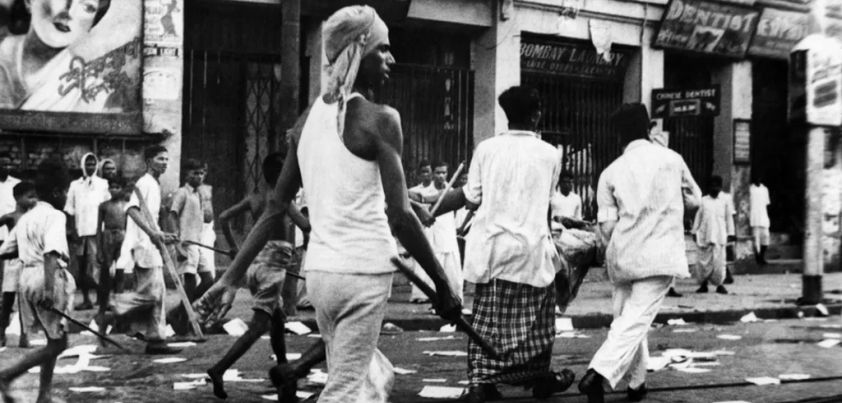 This story by K. A. Abbas uses satire and irony to highlight the madness and futility of the religious riots that killed and displaced millions during the 1947 Partition of India. The Delhi-bred Muslim protagonist not only vilifies Hindus and Sikhs, but also looks down on the crude rustic Punjabi practitioners of his own faith. Like most bigots, he advances no reason for his hatred other than that the three groups have different accents, appearances and customs. Fate plays a cruel trick as an angry mob comes for him. Themes include religious and racial intolerance, fear, violence, sacrifice. More…
This story by K. A. Abbas uses satire and irony to highlight the madness and futility of the religious riots that killed and displaced millions during the 1947 Partition of India. The Delhi-bred Muslim protagonist not only vilifies Hindus and Sikhs, but also looks down on the crude rustic Punjabi practitioners of his own faith. Like most bigots, he advances no reason for his hatred other than that the three groups have different accents, appearances and customs. Fate plays a cruel trick as an angry mob comes for him. Themes include religious and racial intolerance, fear, violence, sacrifice. More…
Category Archives: Short Stories
Lullaby
 Although this story by Leslie Marmon Silko takes place over a single evening, some of the events described span three generations. An aging Native American woman searching for her alcoholic husband reminisces about her life. Although her childhood memories are pleasant, her adult memories are full of loss and tragedy. Her husband has been exploited by a “white rancher” and, having lost at least three children to natural causes and one to war, her last two were removed by “white doctors”. Themes: memories, tradition and change, language barriers, racism, oppression and exploitation, motherhood, death and loss. More…
Although this story by Leslie Marmon Silko takes place over a single evening, some of the events described span three generations. An aging Native American woman searching for her alcoholic husband reminisces about her life. Although her childhood memories are pleasant, her adult memories are full of loss and tragedy. Her husband has been exploited by a “white rancher” and, having lost at least three children to natural causes and one to war, her last two were removed by “white doctors”. Themes: memories, tradition and change, language barriers, racism, oppression and exploitation, motherhood, death and loss. More…
The Chrysanthemums
 In this seemingly straightforward story by John Steinbeck, chrysanthemum-growing Elisa’s character can be interpreted in several, often contradictory, ways. Is she “strong and happy” as her husband says, or weak and disillusioned with her life? Does she crave companionship, intimacy and perhaps a child, or freedom? Is her fascination with chrysanthemums because of a special connection with nature, or because they represent the only joy in her life? Whatever the answers, after a smooth-talking tinker raises her self-esteem and then shatters it, Elisa’s tears signify her realization that nothing will change. Themes: isolation, loneliness, aesthetics, lack of fulfillment, betrayal. More…
In this seemingly straightforward story by John Steinbeck, chrysanthemum-growing Elisa’s character can be interpreted in several, often contradictory, ways. Is she “strong and happy” as her husband says, or weak and disillusioned with her life? Does she crave companionship, intimacy and perhaps a child, or freedom? Is her fascination with chrysanthemums because of a special connection with nature, or because they represent the only joy in her life? Whatever the answers, after a smooth-talking tinker raises her self-esteem and then shatters it, Elisa’s tears signify her realization that nothing will change. Themes: isolation, loneliness, aesthetics, lack of fulfillment, betrayal. More…
Diary of a Madman
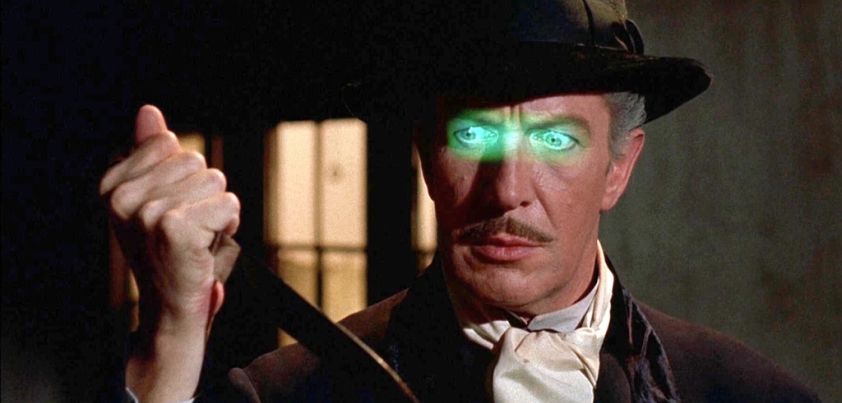 Although not one of Guy de Maupassant’s best known works, this is still a fascinating read. The madman (and in this case thrill killer) is a highly respected magistrate who sentences an innocent man to death for one of his own gruesome murders. Later, he gets an additional thrill from witnessing the poor man’s execution. The motif here is that even seemingly incorruptible members of society can descend into madness and commit the most heinous of crimes. Themes: madness, false impressions, society’s fascination with killing (especially as part of war), the undiscovered madmen among us. More…
Although not one of Guy de Maupassant’s best known works, this is still a fascinating read. The madman (and in this case thrill killer) is a highly respected magistrate who sentences an innocent man to death for one of his own gruesome murders. Later, he gets an additional thrill from witnessing the poor man’s execution. The motif here is that even seemingly incorruptible members of society can descend into madness and commit the most heinous of crimes. Themes: madness, false impressions, society’s fascination with killing (especially as part of war), the undiscovered madmen among us. More…
The Barber’s Trade Union
 The major theme of this inspirational story by Mulk Raj Anand is class as reflected in the Indian caste system. When a young barber tries to improve his appearance by dressing more professionally, he is verbally abused and humiliated by village elders for acting above his “lowly” position in life. Rather than becoming disillusioned and giving in to their ingrained bigotry, he changes the way he works, makes more money than ever before, and ingeniously turns the tables on his detractors. Other themes: human dignity, alienation, appearance, determination, ingenuity, organized labor. More…
The major theme of this inspirational story by Mulk Raj Anand is class as reflected in the Indian caste system. When a young barber tries to improve his appearance by dressing more professionally, he is verbally abused and humiliated by village elders for acting above his “lowly” position in life. Rather than becoming disillusioned and giving in to their ingrained bigotry, he changes the way he works, makes more money than ever before, and ingeniously turns the tables on his detractors. Other themes: human dignity, alienation, appearance, determination, ingenuity, organized labor. More…
Roman Fever
 The major themes of this Edith Wharton story are friendship, rivalry, jealousy, deception and passion. A notable feature is the gradual build-up of animosity between the main characters. Two American widows, lifelong friends, meet up in Rome. The pair have been measuring themselves against each other for most of their lives. The comparisons extend to their daughters, one of whom is more outgoing and vivacious than the other. In an effort to hurt the mother of this girl, the other reveals a cruel secret from the past. In the shattering conclusion, an even crueler secret is thrown back at her. More…
The major themes of this Edith Wharton story are friendship, rivalry, jealousy, deception and passion. A notable feature is the gradual build-up of animosity between the main characters. Two American widows, lifelong friends, meet up in Rome. The pair have been measuring themselves against each other for most of their lives. The comparisons extend to their daughters, one of whom is more outgoing and vivacious than the other. In an effort to hurt the mother of this girl, the other reveals a cruel secret from the past. In the shattering conclusion, an even crueler secret is thrown back at her. More…
The Middleman
 The most succinct summary of this Bharati Mukherjee story I’ve seen came from a Goodreads review: An Iraqi Jew unwittingly aids a Central American revolution. There is obviously a lot more to it, including lust, arms smuggling, treachery and murder. Moreover, rather than being a revolutionary hero, the protagonist is an unscrupulous American criminal on the run from the law. Although he calls himself a “middleman”, we don’t see him act as such. Being new to the country, he is hoping to make a living from things that fall. And something certainly does! Themes: lust, corruption, exploitation, betrayal, violence. More…
The most succinct summary of this Bharati Mukherjee story I’ve seen came from a Goodreads review: An Iraqi Jew unwittingly aids a Central American revolution. There is obviously a lot more to it, including lust, arms smuggling, treachery and murder. Moreover, rather than being a revolutionary hero, the protagonist is an unscrupulous American criminal on the run from the law. Although he calls himself a “middleman”, we don’t see him act as such. Being new to the country, he is hoping to make a living from things that fall. And something certainly does! Themes: lust, corruption, exploitation, betrayal, violence. More…
The Darling
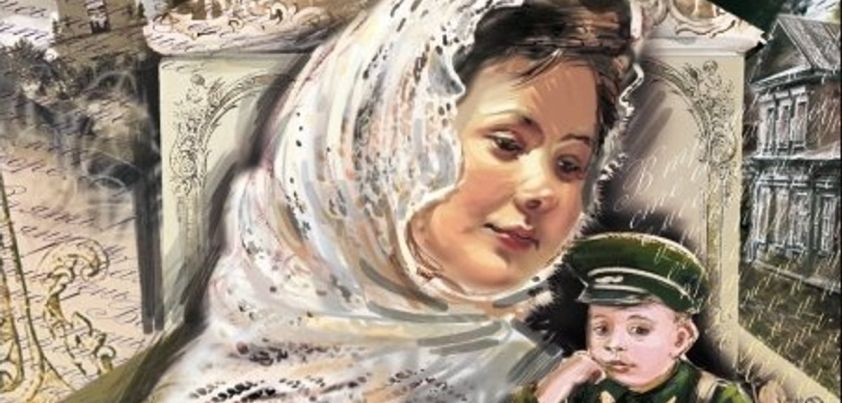 In psychological terms, Anton Chekhov’s ‘darling’ (Olga) suffers from Codependency Personality Disorder. More specifically, she is a vicarious codependent – someone who suspends their identity and gains fulfillment through the accomplishments of another. Olga’s ‘attachments’ in life include her father, a theatre manager, a timber merchant, a veterinary surgeon, and a young boy. Her relationship with the boy differs from the others. Being forced to assume a ‘motherly’ role rekindles Olga’s female identity. Sadly, motherhood and codependency don’t sit well together. In rediscovering her own identity, Olga begins to smother that of the boy. Themes: codependency, subservience, death, abandonment, identity, motherhood. More…
In psychological terms, Anton Chekhov’s ‘darling’ (Olga) suffers from Codependency Personality Disorder. More specifically, she is a vicarious codependent – someone who suspends their identity and gains fulfillment through the accomplishments of another. Olga’s ‘attachments’ in life include her father, a theatre manager, a timber merchant, a veterinary surgeon, and a young boy. Her relationship with the boy differs from the others. Being forced to assume a ‘motherly’ role rekindles Olga’s female identity. Sadly, motherhood and codependency don’t sit well together. In rediscovering her own identity, Olga begins to smother that of the boy. Themes: codependency, subservience, death, abandonment, identity, motherhood. More…
In the Garden of the North American Martyrs
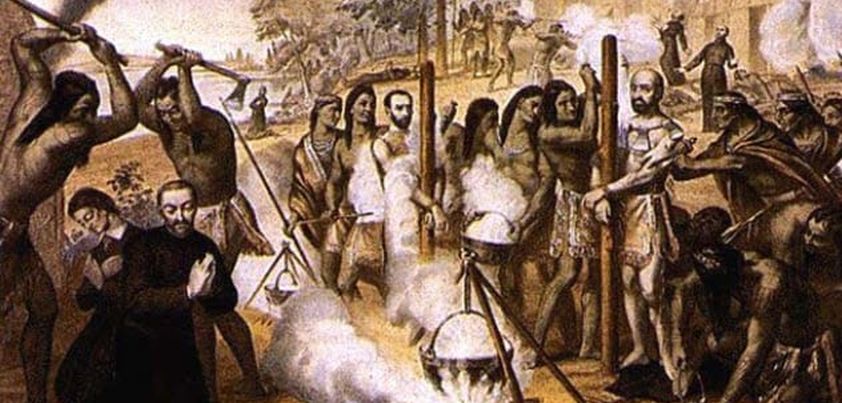 This early Tobias Wolff story is about a college history professor who has always played it safe by expounding non-controversial views. When her East Coast school of fifteen years closes, she finds tenure in Oregon. However, the climate is not to her liking. After gaining an interview for a position in a prestigious college in upstate New York, she learns that she is a token female candidate with no chance of success. Part of the application process is a lecture, where she finds her own voice for the first time. Themes: identity, betrayal, manipulation, academic integrity, conformity vs. original thought. More…
This early Tobias Wolff story is about a college history professor who has always played it safe by expounding non-controversial views. When her East Coast school of fifteen years closes, she finds tenure in Oregon. However, the climate is not to her liking. After gaining an interview for a position in a prestigious college in upstate New York, she learns that she is a token female candidate with no chance of success. Part of the application process is a lecture, where she finds her own voice for the first time. Themes: identity, betrayal, manipulation, academic integrity, conformity vs. original thought. More…
Folie à Deux
 In William Trevor’s Folie à Deux (foolishness shared by two), the protagonist’s chance meeting with a childhood friend brings back memories of a joint act of animal cruelty on an Irish beach. The protagonist has moved on; his friend Anthony has not. Anthony’s way of dealing with his guilt was to withdraw into himself. Over thirty years later, having “disappeared” and been presumed dead, he lives a solitary, reclusive life in Paris, still unable to shake off self-reproach for his part in their actions. Themes: friendship, shared secrets, childhood cruelty, guilt, alienation, rumination (obsessive reliving of traumatic events). More…
In William Trevor’s Folie à Deux (foolishness shared by two), the protagonist’s chance meeting with a childhood friend brings back memories of a joint act of animal cruelty on an Irish beach. The protagonist has moved on; his friend Anthony has not. Anthony’s way of dealing with his guilt was to withdraw into himself. Over thirty years later, having “disappeared” and been presumed dead, he lives a solitary, reclusive life in Paris, still unable to shake off self-reproach for his part in their actions. Themes: friendship, shared secrets, childhood cruelty, guilt, alienation, rumination (obsessive reliving of traumatic events). More…
The Bottom-Pincher
 Khushwant Singh’s writing is known for its use of satire and irony in addressing controversial aspects of Indian life. This humorous story is about an admitted “bottom-watcher” who dreams of becoming a “bottom-pincher”. When he encounters a serial bottom-pincher, he becomes obsessed and stalks the man, obtaining vicarious pleasure from his exploits before succumbing to the temptation himself. The major theme is hypocrisy: the facade of respectability adopted by wealthy Indian men who might pop out for a lunchtime “nooner” or engage in other salacious activities. Additional themes: sexual assault (unwanted touching), perversion, obsession, stalking, harassment, temptation, corruption, poverty. More…
Khushwant Singh’s writing is known for its use of satire and irony in addressing controversial aspects of Indian life. This humorous story is about an admitted “bottom-watcher” who dreams of becoming a “bottom-pincher”. When he encounters a serial bottom-pincher, he becomes obsessed and stalks the man, obtaining vicarious pleasure from his exploits before succumbing to the temptation himself. The major theme is hypocrisy: the facade of respectability adopted by wealthy Indian men who might pop out for a lunchtime “nooner” or engage in other salacious activities. Additional themes: sexual assault (unwanted touching), perversion, obsession, stalking, harassment, temptation, corruption, poverty. More…
The Cat from Hell
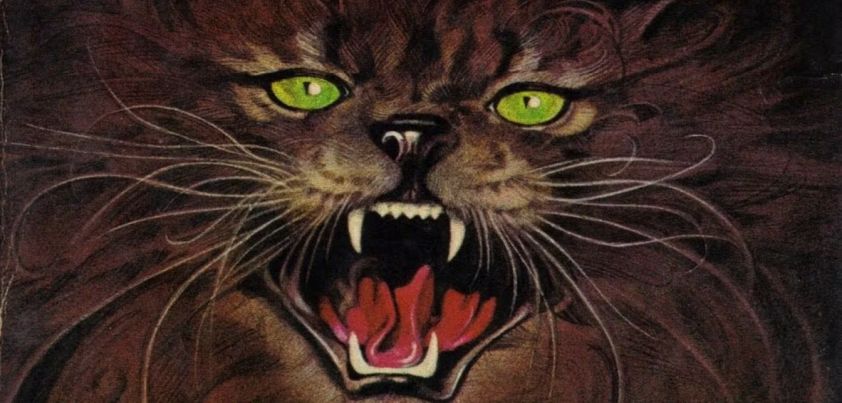 In this story from Stephen King, an aging industrialist hires a hitman to kill an unusual target… his cat. The old man believes the cat, a stray taken in by his sister, is responsible for her death and that of two other members of his household, and fears he will be next. The hitman accepts the job and takes the cat, which was purring peacefully on his lap as they talked, away. Unfortunately for him, the tables are soon turned in a most gruesome way. Themes include appearance vs. reality, fear, animal testing and suffering, demonic retribution, the supernatural. More…
In this story from Stephen King, an aging industrialist hires a hitman to kill an unusual target… his cat. The old man believes the cat, a stray taken in by his sister, is responsible for her death and that of two other members of his household, and fears he will be next. The hitman accepts the job and takes the cat, which was purring peacefully on his lap as they talked, away. Unfortunately for him, the tables are soon turned in a most gruesome way. Themes include appearance vs. reality, fear, animal testing and suffering, demonic retribution, the supernatural. More…
Glory
 Glory (aka Glorybetogod), the protagonist in this Lesley Nneka Arimah story, is so screwed-up and irresponsible as to be almost likeable. As foreshadowed by her grandfather at birth, Glory’s history is one of poor life choices. At the end of the story, she has yet another decision to make. A “yes” will lead to the kind of life that most single Nigerian women her age dream of. A “no” could send her back to contemplating how a bottle of Moscato would pair with thirty gelcap sleeping pills. Themes: superstition, parental expectations, choices and consequences. More…
Glory (aka Glorybetogod), the protagonist in this Lesley Nneka Arimah story, is so screwed-up and irresponsible as to be almost likeable. As foreshadowed by her grandfather at birth, Glory’s history is one of poor life choices. At the end of the story, she has yet another decision to make. A “yes” will lead to the kind of life that most single Nigerian women her age dream of. A “no” could send her back to contemplating how a bottle of Moscato would pair with thirty gelcap sleeping pills. Themes: superstition, parental expectations, choices and consequences. More…
A Retrieved Reformation
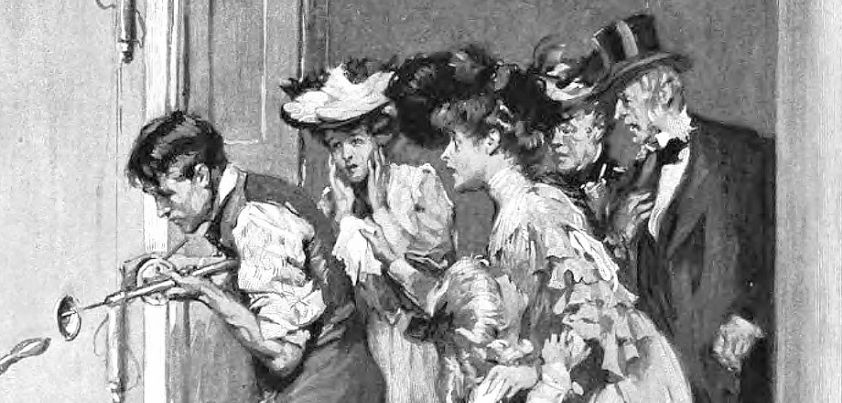 In this story from William porter (aka O. Henry), safe-cracker Jimmy Valentine gives up his life of crime for love. He changes his identity, builds a successful business, and becomes a model citizen. Unfortunately, police detective Ben Price is hot on Jimmy’s trail. The title reflects Price’s decision to let Jimmy “retrieve” his “reformed” life after witnessing him risk it all to save a child. Themes: love, reform, redemption and identity. Love succeeds in reforming Jimmy where the justice system had failed. Redemption comes with Jimmy’s potential sacrifice. A possible moral: there is a Ralph Spenser (good side) in everyone. More…
In this story from William porter (aka O. Henry), safe-cracker Jimmy Valentine gives up his life of crime for love. He changes his identity, builds a successful business, and becomes a model citizen. Unfortunately, police detective Ben Price is hot on Jimmy’s trail. The title reflects Price’s decision to let Jimmy “retrieve” his “reformed” life after witnessing him risk it all to save a child. Themes: love, reform, redemption and identity. Love succeeds in reforming Jimmy where the justice system had failed. Redemption comes with Jimmy’s potential sacrifice. A possible moral: there is a Ralph Spenser (good side) in everyone. More…
All the King’s Horses
 The major theme of this Cold War allegory from Kurt Vonnegut is the human cost involved in resolving armed conflicts. The focus of the story is the moral dilemma faced by those in ultimate command… the need to put personal feelings aside and make strategic decisions that are likely to result in collateral losses. The story also reflects the dynamics of power in war: how the ordinary soldier, general population, and even vassal powers such as Pi Ying’s rebels, are mere pawns in a “game” beyond their control. Other themes: cruelty, dehumanization, sacrifice, manipulation. More…
The major theme of this Cold War allegory from Kurt Vonnegut is the human cost involved in resolving armed conflicts. The focus of the story is the moral dilemma faced by those in ultimate command… the need to put personal feelings aside and make strategic decisions that are likely to result in collateral losses. The story also reflects the dynamics of power in war: how the ordinary soldier, general population, and even vassal powers such as Pi Ying’s rebels, are mere pawns in a “game” beyond their control. Other themes: cruelty, dehumanization, sacrifice, manipulation. More…
The Hack Driver
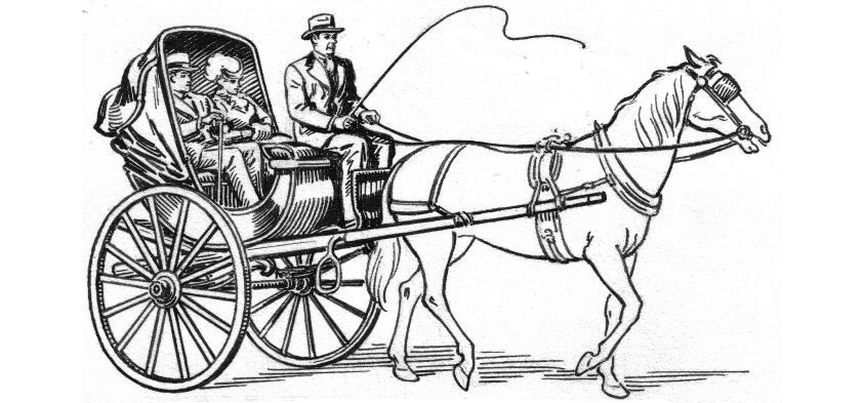 In this amusing story by Sinclair Lewis, a newly qualified lawyer is sent to a small town forty miles into the countryside to serve a summons on a man needed for an important case. Although unsuccessful, he thoroughly enjoys his time with the helpful hack driver who drives him around all day, always one step behind his elusive quarry. He returns the next day with someone who knows the man he was looking for, and finds him standing beside his hack at the station. Themes include naivety, blind faith, deception and trickery, country vs. city life. More…
In this amusing story by Sinclair Lewis, a newly qualified lawyer is sent to a small town forty miles into the countryside to serve a summons on a man needed for an important case. Although unsuccessful, he thoroughly enjoys his time with the helpful hack driver who drives him around all day, always one step behind his elusive quarry. He returns the next day with someone who knows the man he was looking for, and finds him standing beside his hack at the station. Themes include naivety, blind faith, deception and trickery, country vs. city life. More…
The Woman Who Came at Six O’Clock
 The central theme of this early Gabriel Garcia Márquez story is perception of others. ‘Queen’, the six o’clock regular in José’s restaurant, is a prostitute. Queen’s customers see her as a sex object, to be used and sometimes abused. The police see her as an alcoholic miscreant who cannot be trusted. José, who professes platonic love for Queen, sees the vulnerable human being within. Queen, who claims to be disgusted by all men, sees the caring, kind-hearted José only as someone to be taken advantage of. Other themes: habit, murder, naïveté vs. worldliness, misunderstanding, reputation. More…
The central theme of this early Gabriel Garcia Márquez story is perception of others. ‘Queen’, the six o’clock regular in José’s restaurant, is a prostitute. Queen’s customers see her as a sex object, to be used and sometimes abused. The police see her as an alcoholic miscreant who cannot be trusted. José, who professes platonic love for Queen, sees the vulnerable human being within. Queen, who claims to be disgusted by all men, sees the caring, kind-hearted José only as someone to be taken advantage of. Other themes: habit, murder, naïveté vs. worldliness, misunderstanding, reputation. More…
The Love Potion
 A major theme of this Herman Bosman story is the importance of tradition, myth and storytelling in the lives of Boer settlers. The narrator begins by asserting that everyone in the Marico knows that juba-berry juice can make a woman fall in love with a man. He then relates a tongue-in-cheek story of how he once “helped” a shy policeman use the juice to win a girl’s heart. The ambiguous ending leaves it unclear whether the potion really worked. Other themes: love, fear of rejection, superstition/magic vs. reality, morality (lack of respect for the girl and her right to decide). More…
A major theme of this Herman Bosman story is the importance of tradition, myth and storytelling in the lives of Boer settlers. The narrator begins by asserting that everyone in the Marico knows that juba-berry juice can make a woman fall in love with a man. He then relates a tongue-in-cheek story of how he once “helped” a shy policeman use the juice to win a girl’s heart. The ambiguous ending leaves it unclear whether the potion really worked. Other themes: love, fear of rejection, superstition/magic vs. reality, morality (lack of respect for the girl and her right to decide). More…
The Disappearance
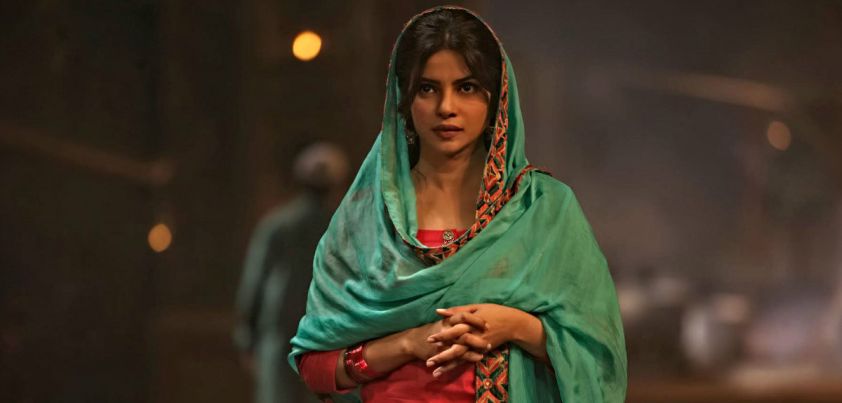 Chitra Divakaruni’s hard-hitting story of a woman’s “disappearance” is told from her Indian-American husband’s point of view. After a year of denial, he accepts that she has left him. Their arranged marriage, although blessed with a son, had become intolerable for her. Years later, living in a nursing home and estranged from their son, he reflects on how much his wife must have hated him to leave the boy. The old man still fails to appreciate the effect his repression and sexual abuse would have had upon the poor woman! Themes include insensitivity, authoritarianism, marital rape. More…
Chitra Divakaruni’s hard-hitting story of a woman’s “disappearance” is told from her Indian-American husband’s point of view. After a year of denial, he accepts that she has left him. Their arranged marriage, although blessed with a son, had become intolerable for her. Years later, living in a nursing home and estranged from their son, he reflects on how much his wife must have hated him to leave the boy. The old man still fails to appreciate the effect his repression and sexual abuse would have had upon the poor woman! Themes include insensitivity, authoritarianism, marital rape. More…
In the Region of Ice
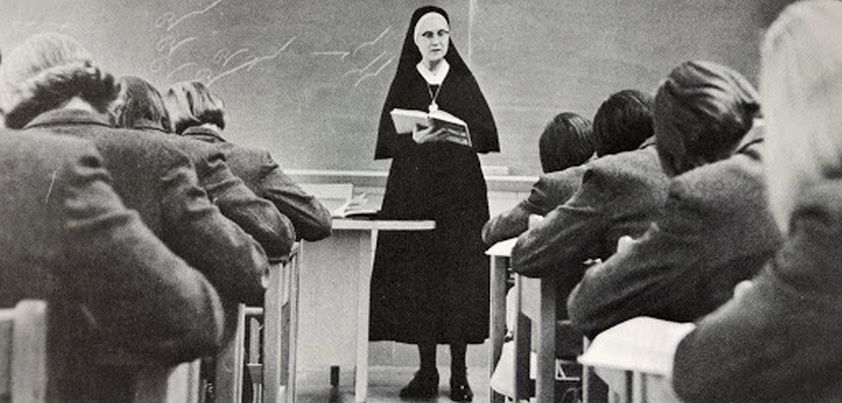 In this story by Joyce Carol Oates, a young nun teaching her first semester at a Jesuit university is confident in her academic role but feels confused and alienated by the outside world. Things change when a brilliant but mentally disturbed Jewish graduate student joins her literature class. Although stimulated by his questions and probing mind, he exhibits a need for emotional support beyond her comfort zone. When she refuses a request to lend him money and take his hand, he becomes hysterical and verbally abusive. Themes include identity, connection (emotional detachment), mental illness, alienation, faith, compassion. More…
In this story by Joyce Carol Oates, a young nun teaching her first semester at a Jesuit university is confident in her academic role but feels confused and alienated by the outside world. Things change when a brilliant but mentally disturbed Jewish graduate student joins her literature class. Although stimulated by his questions and probing mind, he exhibits a need for emotional support beyond her comfort zone. When she refuses a request to lend him money and take his hand, he becomes hysterical and verbally abusive. Themes include identity, connection (emotional detachment), mental illness, alienation, faith, compassion. More…
The Happiest I’ve Been
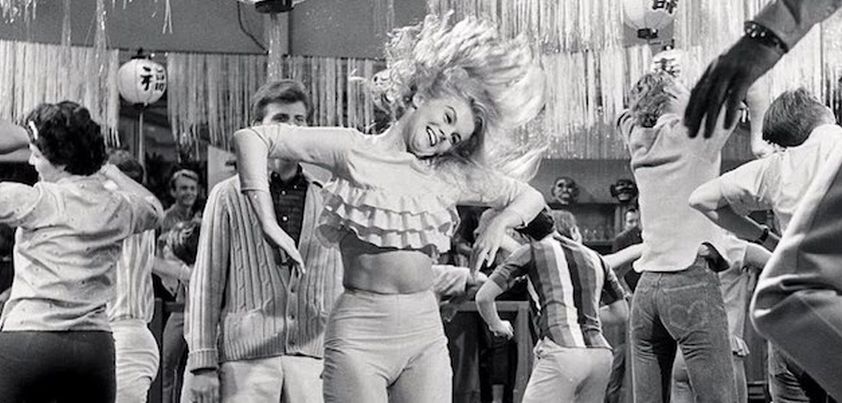 This acclaimed story from John Updike concludes with the protagonist attributing his overwhelming happiness to driving a powerful car through the stunning Pennsylvania countryside, blessed irresponsibility, a waiting girl who would marry him, and twice being trusted enough for someone to fall asleep beside him. The second-year university student is on the cusp of manhood. Observing the party he had been going to all his life the previous night taught the shy loner that he, along with his friends, have out-grown childhood and need to move on with their lives. Themes: solitude, nostalgia, transition (from childhood to adulthood), looking ahead. More…
This acclaimed story from John Updike concludes with the protagonist attributing his overwhelming happiness to driving a powerful car through the stunning Pennsylvania countryside, blessed irresponsibility, a waiting girl who would marry him, and twice being trusted enough for someone to fall asleep beside him. The second-year university student is on the cusp of manhood. Observing the party he had been going to all his life the previous night taught the shy loner that he, along with his friends, have out-grown childhood and need to move on with their lives. Themes: solitude, nostalgia, transition (from childhood to adulthood), looking ahead. More…
The Cask of Amontillado
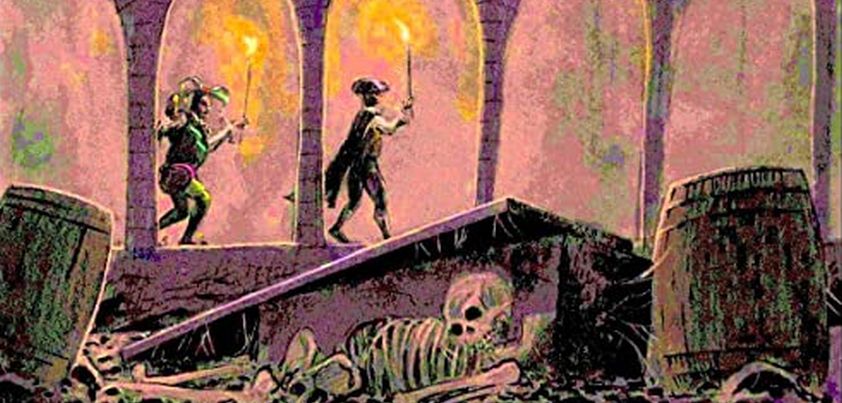 There is not much one can add to what has already been written about this classic tale from Edgar Allan Poe. Widely regarded as one of the world’s greatest Gothic horror stories, it is yet another example of Poe’s ability to supplement situational horror with insights into the twisted minds of his protagonists. The horror aspect of this story about a wine-tasting gone wrong (or right, depending on how you look at it) is enhanced by the ambiguity about the seriousness of the “insult” that lead to the victim’s claustrophobic end. Themes: revenge, trust/deceit, pride, envy, mortality, confession. More…
There is not much one can add to what has already been written about this classic tale from Edgar Allan Poe. Widely regarded as one of the world’s greatest Gothic horror stories, it is yet another example of Poe’s ability to supplement situational horror with insights into the twisted minds of his protagonists. The horror aspect of this story about a wine-tasting gone wrong (or right, depending on how you look at it) is enhanced by the ambiguity about the seriousness of the “insult” that lead to the victim’s claustrophobic end. Themes: revenge, trust/deceit, pride, envy, mortality, confession. More…
Love Must Not Be Forgotten
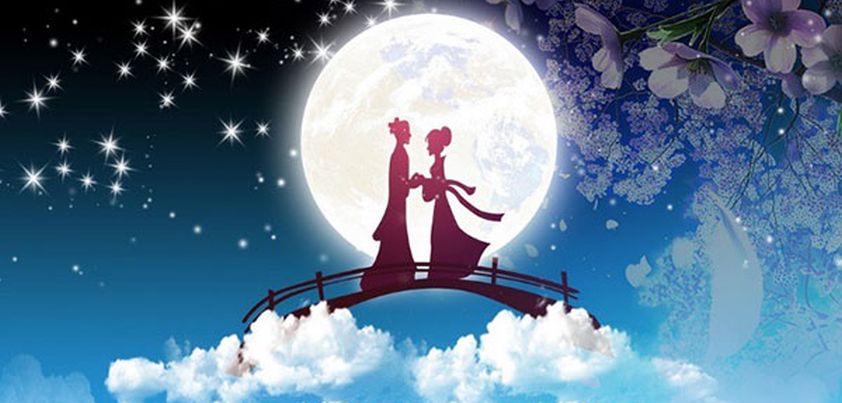 This story from Zhang Jie challenges the traditional (1970s) Chinese view that a woman’s duty is to marry and raise a family. The protagonist has concerns about her relationship with a seemingly “ideal” man, questioning both their feelings for one another and the poor guy’s intelligence. After reflecting on memories of growing up and insights gained from her deceased mother’s diary, she reaches the progressive conclusion that remaining single and waiting for the right man is better than a loveless marriage. Themes: social pressure, marriage, the nature of love, mother-daughter relationships, courage, Communist ideology. More…
This story from Zhang Jie challenges the traditional (1970s) Chinese view that a woman’s duty is to marry and raise a family. The protagonist has concerns about her relationship with a seemingly “ideal” man, questioning both their feelings for one another and the poor guy’s intelligence. After reflecting on memories of growing up and insights gained from her deceased mother’s diary, she reaches the progressive conclusion that remaining single and waiting for the right man is better than a loveless marriage. Themes: social pressure, marriage, the nature of love, mother-daughter relationships, courage, Communist ideology. More…
Silver Water
 Amy Bloom’s deeply moving Silver Water examines an often-overlooked aspect of mental illness: its impact on the sufferer’s family. Throughout the story, the parents (Galen and David) and their two “warrior queen” daughters struggle to navigate their way through inadequate medical insurance and mental illness support systems. In the process, they demonstrate what family love is all about. There is considerable irony in the fact that David (a psychiatrist!) not only failed to diagnose his daughter’s condition, but also has the most difficulty coping with her at home. Themes: mental illness, family love, death as a relief. More…
Amy Bloom’s deeply moving Silver Water examines an often-overlooked aspect of mental illness: its impact on the sufferer’s family. Throughout the story, the parents (Galen and David) and their two “warrior queen” daughters struggle to navigate their way through inadequate medical insurance and mental illness support systems. In the process, they demonstrate what family love is all about. There is considerable irony in the fact that David (a psychiatrist!) not only failed to diagnose his daughter’s condition, but also has the most difficulty coping with her at home. Themes: mental illness, family love, death as a relief. More…
A Christmas Story
 In this Christmas story from Walter Dean Myers, a shrewd old woman teaches a new police patrolman an important lesson by inviting his family to Christmas dinner. Along with his co-workers, the policeman has a negative view of Harlem (the poor, often violent African American neighborhood in which he works) and doesn’t think it a fit place for a family visit. His wife insists on going, and the visit reveals another side of the community: “regular”, churchgoing families exchanging Christmas greetings on the street and celebrating the holiday together. Themes: Christmas, community, prejudice, understanding, aging gracefully, caring, sharing. More…
In this Christmas story from Walter Dean Myers, a shrewd old woman teaches a new police patrolman an important lesson by inviting his family to Christmas dinner. Along with his co-workers, the policeman has a negative view of Harlem (the poor, often violent African American neighborhood in which he works) and doesn’t think it a fit place for a family visit. His wife insists on going, and the visit reveals another side of the community: “regular”, churchgoing families exchanging Christmas greetings on the street and celebrating the holiday together. Themes: Christmas, community, prejudice, understanding, aging gracefully, caring, sharing. More…
The First Year of My Life
 The protagonist of this light-hearted anti-war story by Muriel Spark is an omniscient baby who can “tune in” to world events and the thoughts of famous people from her crib. Born in the final year of World War I, she contrasts the bloody battlefields of Europe with the almost business as usual atmosphere in London. She also shares her observations of selected world leaders, politicians, literary figures and celebrities. Themes: the horrors and futility of war; the British public’s ignorance of the true extent of human suffering; the lack of moral leadership from influential members of the artistic community. More…
The protagonist of this light-hearted anti-war story by Muriel Spark is an omniscient baby who can “tune in” to world events and the thoughts of famous people from her crib. Born in the final year of World War I, she contrasts the bloody battlefields of Europe with the almost business as usual atmosphere in London. She also shares her observations of selected world leaders, politicians, literary figures and celebrities. Themes: the horrors and futility of war; the British public’s ignorance of the true extent of human suffering; the lack of moral leadership from influential members of the artistic community. More…
How Sweet It Is to Die in the Sea
 In this entertaining story by José Eduardo Agualusa, a successful novelist’s marriage falls apart when he takes to drink after his latest book is panned by a literary critic. He makes ends meet by becoming a critic himself, and takes delight in panning a novel by the critic who panned his. He starts a new life and, when a “friend” kills the critic, his second wife, and her two lovers, secures a rich inheritance and is provided with a good plot for a new book. Themes include writing and literary criticism, alcohol abuse, despair, betrayal, renewal. More…
In this entertaining story by José Eduardo Agualusa, a successful novelist’s marriage falls apart when he takes to drink after his latest book is panned by a literary critic. He makes ends meet by becoming a critic himself, and takes delight in panning a novel by the critic who panned his. He starts a new life and, when a “friend” kills the critic, his second wife, and her two lovers, secures a rich inheritance and is provided with a good plot for a new book. Themes include writing and literary criticism, alcohol abuse, despair, betrayal, renewal. More…
Three Skeleton Key
 Last year we featured Leiningen Versus the Ants, a story in which 400 men try to fight off an army of killer ants. In today’s tale by George Toudouze, three men are trapped inside an isolated lighthouse, surrounded by a horde of starving rats. One of the men is prone to panic and loses his mind when the rats break in to the lower part of the tower. The other two remain calm and, although a serious breach of duty, agree on a desperate course of action that saves the day. Themes: man vs. nature, fear, calmness under pressure. More…
Last year we featured Leiningen Versus the Ants, a story in which 400 men try to fight off an army of killer ants. In today’s tale by George Toudouze, three men are trapped inside an isolated lighthouse, surrounded by a horde of starving rats. One of the men is prone to panic and loses his mind when the rats break in to the lower part of the tower. The other two remain calm and, although a serious breach of duty, agree on a desperate course of action that saves the day. Themes: man vs. nature, fear, calmness under pressure. More…
Clean Sweep Ignatius
 Jeffrey Archer has come up with an almost unimaginable scenario. Nigeria has a new Finance Minister, Ignatius Agarbi, who decides to clear up his country’s reputation for corruption! He does such a good job, without so much as a breath of scandal, that the country’s President commissions him to find out the names of all ministers and government officials with money hidden away in secret Swiss bank accounts. Diligent as always, Ignatius devises a seemingly foolproof plan to find out just how serious Swiss banks are in maintaining their code of privacy. Themes: corruption, creativity, honor. More…
Jeffrey Archer has come up with an almost unimaginable scenario. Nigeria has a new Finance Minister, Ignatius Agarbi, who decides to clear up his country’s reputation for corruption! He does such a good job, without so much as a breath of scandal, that the country’s President commissions him to find out the names of all ministers and government officials with money hidden away in secret Swiss bank accounts. Diligent as always, Ignatius devises a seemingly foolproof plan to find out just how serious Swiss banks are in maintaining their code of privacy. Themes: corruption, creativity, honor. More…
The Kugelmass Episode
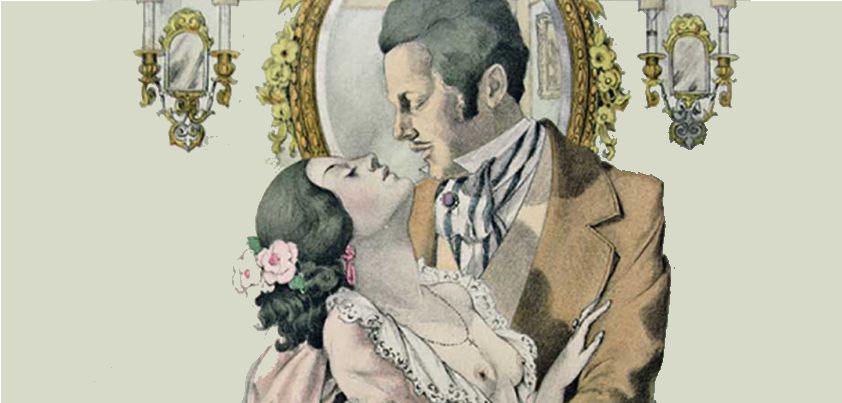 This Woody Allen story includes elements of fantasy, science fiction and farce. Kugelmass, bored with his “oafish” wife, wants a lustful extra-marital affair with no commitments either way. His wish seemingly comes true when a failed magician offers him a chance to seduce any woman from world literature. His first choice begins well, but ends badly; his second proves disastrous. The story is a cutting satire of America’s 1970s ‘Me’ culture. Themes include psychological well-being, marital relationships and casual sex. Ironically, instead of “having” the affair he wanted, Kugelmass spends the rest of eternity running from hairy, long-legged Spanish “haves”. More…
This Woody Allen story includes elements of fantasy, science fiction and farce. Kugelmass, bored with his “oafish” wife, wants a lustful extra-marital affair with no commitments either way. His wish seemingly comes true when a failed magician offers him a chance to seduce any woman from world literature. His first choice begins well, but ends badly; his second proves disastrous. The story is a cutting satire of America’s 1970s ‘Me’ culture. Themes include psychological well-being, marital relationships and casual sex. Ironically, instead of “having” the affair he wanted, Kugelmass spends the rest of eternity running from hairy, long-legged Spanish “haves”. More…
Saboteur
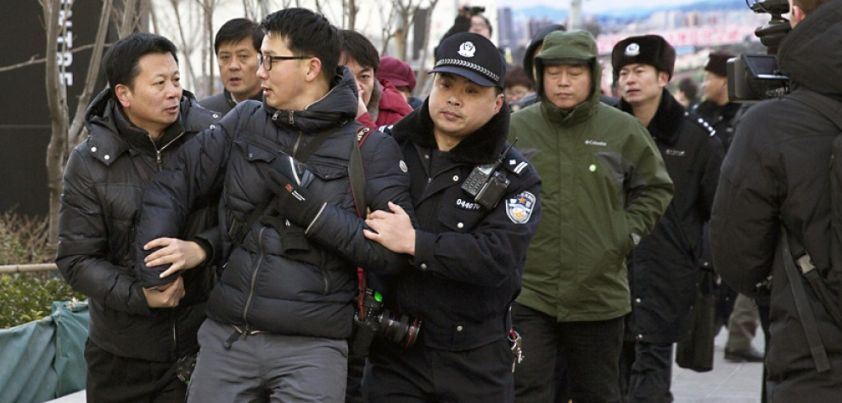 This story from Ha Jin begins with what appears to be a simple shakedown attempt by two corrupt Chinese policemen. The victim, who should have known better, attracts the attention of onlookers (who do nothing), resists arrest (a bad move) and challenges their station officer’s authority (bringing a weekend locked up in miserable conditions). When forced to “confess”, he faces loss of his reputation, job and wife. On release, he morphs from victim to villain. The original trumped-up charge was sabotage; his act of revenge is more like biological terrorism! Themes: police brutality and abuse of power, injustice, capitulation, revenge. More…
This story from Ha Jin begins with what appears to be a simple shakedown attempt by two corrupt Chinese policemen. The victim, who should have known better, attracts the attention of onlookers (who do nothing), resists arrest (a bad move) and challenges their station officer’s authority (bringing a weekend locked up in miserable conditions). When forced to “confess”, he faces loss of his reputation, job and wife. On release, he morphs from victim to villain. The original trumped-up charge was sabotage; his act of revenge is more like biological terrorism! Themes: police brutality and abuse of power, injustice, capitulation, revenge. More…
The Color Master
 In this folktale-like story by Aimee Bender, a group of artisans skilled in making fine clothing and footwear receive several difficult commissions from a king. The story is a loosely based prequel to the fairy tale Donkey Skin, in which a princess demands three dresses of seemingly impossible color (the sky, the moon and the sun) to avoid having to marry her father. In the process of directing the work, the dying Color Master anoints a successor and, in instructing her to put anger into the creations, saves the princess. Themes include artisanship, succession, faith, unnatural love (incest).
In this folktale-like story by Aimee Bender, a group of artisans skilled in making fine clothing and footwear receive several difficult commissions from a king. The story is a loosely based prequel to the fairy tale Donkey Skin, in which a princess demands three dresses of seemingly impossible color (the sky, the moon and the sun) to avoid having to marry her father. In the process of directing the work, the dying Color Master anoints a successor and, in instructing her to put anger into the creations, saves the princess. Themes include artisanship, succession, faith, unnatural love (incest).
Korea
 Despite the title, this acclaimed story from John McGahern has almost nothing to do with Korea. Set in Ireland, a father opens up to his teenage son about his traumatic experiences during the War of Independence. He was clearly scarred by them, and may have suffered what we now know as PTSD. The son is about to leave school, and the father encourages him to consider emigrating to America for a better life. The son later learns that what the father is really hoping for is a better life for himself. Themes: war, father-son relationships, desperation, betrayal, coming of age. More…
Despite the title, this acclaimed story from John McGahern has almost nothing to do with Korea. Set in Ireland, a father opens up to his teenage son about his traumatic experiences during the War of Independence. He was clearly scarred by them, and may have suffered what we now know as PTSD. The son is about to leave school, and the father encourages him to consider emigrating to America for a better life. The son later learns that what the father is really hoping for is a better life for himself. Themes: war, father-son relationships, desperation, betrayal, coming of age. More…
Woman Hollering Creek
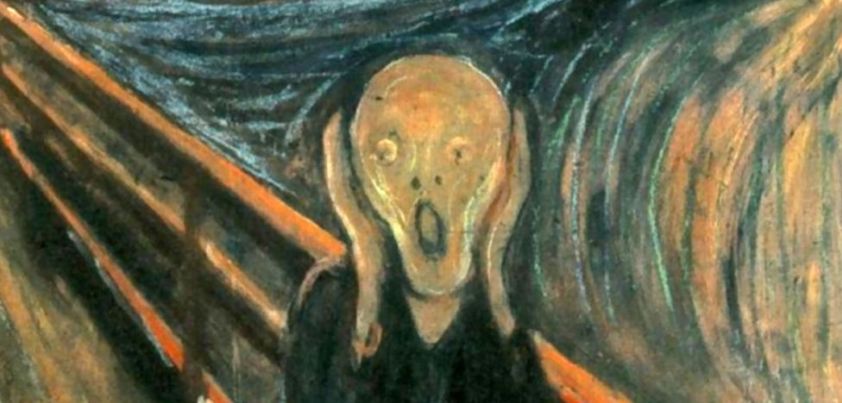 Cleófilas, Sandra Cisneros’s Mexican protagonist, finds the grass no greener when she marries and moves to a town “on the other side”. Poverty, language and distance leave her with nobody to turn to when her dreams of love and passion become a nightmare. Fortunately, her father has foreseen the possibility and left the home door open. Thanks to a kind woman with a pickup truck and piercing scream, she returns stronger and, one hopes, empowered to strive for a better future. Themes: parental vs. romantic love, cultural traditions (wives as ‘property’), gender roles, isolation, marital abuse. More…
Cleófilas, Sandra Cisneros’s Mexican protagonist, finds the grass no greener when she marries and moves to a town “on the other side”. Poverty, language and distance leave her with nobody to turn to when her dreams of love and passion become a nightmare. Fortunately, her father has foreseen the possibility and left the home door open. Thanks to a kind woman with a pickup truck and piercing scream, she returns stronger and, one hopes, empowered to strive for a better future. Themes: parental vs. romantic love, cultural traditions (wives as ‘property’), gender roles, isolation, marital abuse. More…
House Taken Over
 Said to be Julio Cortázar’s first published story, this suspenseful tale is about a middle-aged brother and sister who, having never married, live quiet but contented lives in their aging family mansion. One night, their solitude is interrupted by strange noises coming from a disused wing of the house. The brother locks and bolts the door leading to that part of the house. Unfortunately, the title foreshadows the final outcome. The brother and sister know the identity of the intruders (referred to only as “they”), but this is not shared with the reader. Themes: the idle rich, isolation, fear, change. More…
Said to be Julio Cortázar’s first published story, this suspenseful tale is about a middle-aged brother and sister who, having never married, live quiet but contented lives in their aging family mansion. One night, their solitude is interrupted by strange noises coming from a disused wing of the house. The brother locks and bolts the door leading to that part of the house. Unfortunately, the title foreshadows the final outcome. The brother and sister know the identity of the intruders (referred to only as “they”), but this is not shared with the reader. Themes: the idle rich, isolation, fear, change. More…
A Passion in the Desert
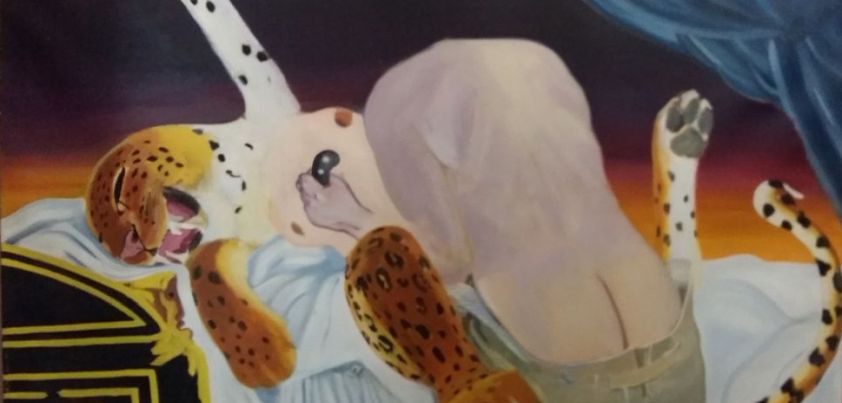 This story by Honoré de Balzac recounts the adventures of a French soldier lost in the Egyptian desert during the Napoleonic conquests. He finds a small oasis, but soon realizes that it is already occupied… by a leopard! He befriends the beast and the two manage to co-exist, with the leopard becoming more and more trusting and playful. Although he describes the (female) leopard in increasingly sensual terms, he later learns that the desert holds other passions: (In the desert there is everything and nothing… it is God without mankind.) Themes: isolation, animal/human bonding, distrust, betrayal, finding God in nature. More…
This story by Honoré de Balzac recounts the adventures of a French soldier lost in the Egyptian desert during the Napoleonic conquests. He finds a small oasis, but soon realizes that it is already occupied… by a leopard! He befriends the beast and the two manage to co-exist, with the leopard becoming more and more trusting and playful. Although he describes the (female) leopard in increasingly sensual terms, he later learns that the desert holds other passions: (In the desert there is everything and nothing… it is God without mankind.) Themes: isolation, animal/human bonding, distrust, betrayal, finding God in nature. More…
The Green Leaves
 This story from Grace Ogot reads like a folktale. With an overall theme of culture conflict between the modern world and the traditions and beliefs of a Kenyan tribe, the plot can be divided into three sections. The first (ending with Nyagar’s death) has themes of crime, tribal justice, violence, superstition and greed. The second, involving the British authorities, emphasizes colonial arrogance and cultural insensitivity. The third, in which Nyagar’s wife laments his death, introduces a feminist theme. Her chant reflects not only her own loss, but also the powerlessness and complete dependence of all village women on their husbands. More…
This story from Grace Ogot reads like a folktale. With an overall theme of culture conflict between the modern world and the traditions and beliefs of a Kenyan tribe, the plot can be divided into three sections. The first (ending with Nyagar’s death) has themes of crime, tribal justice, violence, superstition and greed. The second, involving the British authorities, emphasizes colonial arrogance and cultural insensitivity. The third, in which Nyagar’s wife laments his death, introduces a feminist theme. Her chant reflects not only her own loss, but also the powerlessness and complete dependence of all village women on their husbands. More…
A Worn Path
 In this Eudora Welty story, an aged woman makes a long, dangerous trek through the Mississippi woods. Its power lies in the vivid descriptions of nature and the various obstacles she encounters. Once in town, she struggles to remember the purpose of the journey. Although we learn later that she has come for the regular medicine needed by her ailing grandson, many readers question if the boy still lives. Her confusion suggests that such visits may simply be a way of handling the grief (or guilt) associated with his death. Themes: nature, old age, perseverance, duty, poverty, dignity, racism, redemption. More…
In this Eudora Welty story, an aged woman makes a long, dangerous trek through the Mississippi woods. Its power lies in the vivid descriptions of nature and the various obstacles she encounters. Once in town, she struggles to remember the purpose of the journey. Although we learn later that she has come for the regular medicine needed by her ailing grandson, many readers question if the boy still lives. Her confusion suggests that such visits may simply be a way of handling the grief (or guilt) associated with his death. Themes: nature, old age, perseverance, duty, poverty, dignity, racism, redemption. More…
Han’s Crime
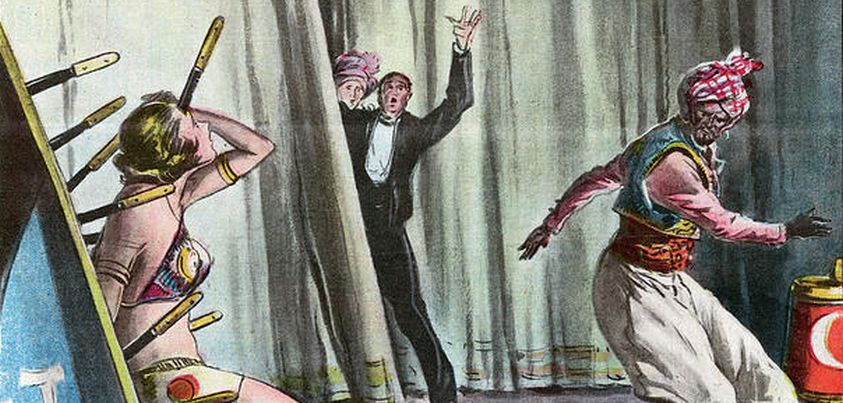 The crime referred to in this fascinating psychological narrative by Shiga Naoya is either murder or manslaughter. A theatre performer (Han) kills his wife during a knife-throwing act. At the end of questioning, the judge asks: Do you not feel the slightest sorrow for your wife’s death? Han answers: None at all! …I never could have imagined I would feel such happiness in talking about her death. The judge (and readers) must decide if the death was a crime or terrible accident. Themes: illegitimacy, infanticide, toxic marriage, conscious vs unconscious actions, legal vs moral guilt, doubt vs certainty. More…
The crime referred to in this fascinating psychological narrative by Shiga Naoya is either murder or manslaughter. A theatre performer (Han) kills his wife during a knife-throwing act. At the end of questioning, the judge asks: Do you not feel the slightest sorrow for your wife’s death? Han answers: None at all! …I never could have imagined I would feel such happiness in talking about her death. The judge (and readers) must decide if the death was a crime or terrible accident. Themes: illegitimacy, infanticide, toxic marriage, conscious vs unconscious actions, legal vs moral guilt, doubt vs certainty. More…
Dog Star
 Dog Star illustrates science fiction writer Arthur C. Clarke’s sentimental side. Despite the title, the story has nothing to do with stars of the celestial kind. It does however feature a dog. An introverted astronomer finds and raises a lost puppy. On two occasions, the dog’s heightened senses save his life. The second time, the dog had been long dead. If you love animals, especially dogs, you are sure to be moved by the story. But BE WARNED… the conclusion has been known to bring tears to the eyes. Themes: kindness, human/animal bonding, career sacrifice, supernatural connections. More…
Dog Star illustrates science fiction writer Arthur C. Clarke’s sentimental side. Despite the title, the story has nothing to do with stars of the celestial kind. It does however feature a dog. An introverted astronomer finds and raises a lost puppy. On two occasions, the dog’s heightened senses save his life. The second time, the dog had been long dead. If you love animals, especially dogs, you are sure to be moved by the story. But BE WARNED… the conclusion has been known to bring tears to the eyes. Themes: kindness, human/animal bonding, career sacrifice, supernatural connections. More…
Everything That Rises Must Converge
 Flannery O’connor is known for emphasizing her themes through flawed, often thoroughly dislikeable characters. In this story, she has paired a bigoted mother living in the past with a callous, disrespectful son. The son, a college graduate, considers himself intellectually and morally superior to his mother and delights in antagonizing the poor woman. The unfortunate climax comes at the end of a city bus trip when the mother insults her African American “doppelganger” by offering the woman’s young child a penny. Themes include (through Mrs. Chestny) sacrifice, heritage & appearance vs. character, racism; (through Julian) lack of respect, cruelty, self-deception. More…
Flannery O’connor is known for emphasizing her themes through flawed, often thoroughly dislikeable characters. In this story, she has paired a bigoted mother living in the past with a callous, disrespectful son. The son, a college graduate, considers himself intellectually and morally superior to his mother and delights in antagonizing the poor woman. The unfortunate climax comes at the end of a city bus trip when the mother insults her African American “doppelganger” by offering the woman’s young child a penny. Themes include (through Mrs. Chestny) sacrifice, heritage & appearance vs. character, racism; (through Julian) lack of respect, cruelty, self-deception. More…
Toba Tek Singh
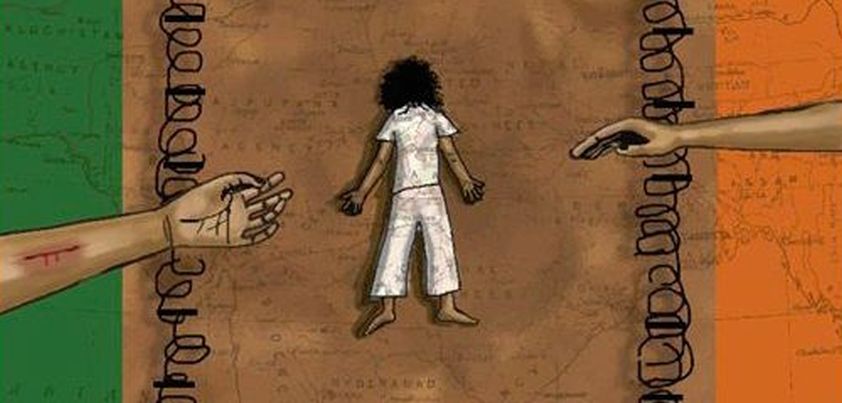 This month marks the 75th anniversary of the partition of British India into two countries: Hindustan and Pakistan. Some years ago we featured Rajinder Singh Bedi’s Lajwanti, a Partition story from an Indian viewpoint. In honor of the occasion, we are pleased to provide this story from the Pakistan side by controversial writer Saadat Hasan Manto. This is not your usual Partition story of mass displacement and violence. Instead, it is a clever satire of the governments of the two countries, as reflected in a decision several years later to exchange institutionalized lunatics. Themes: insanity, separation, religious segregation, nationality, confusion, belonging. More…
This month marks the 75th anniversary of the partition of British India into two countries: Hindustan and Pakistan. Some years ago we featured Rajinder Singh Bedi’s Lajwanti, a Partition story from an Indian viewpoint. In honor of the occasion, we are pleased to provide this story from the Pakistan side by controversial writer Saadat Hasan Manto. This is not your usual Partition story of mass displacement and violence. Instead, it is a clever satire of the governments of the two countries, as reflected in a decision several years later to exchange institutionalized lunatics. Themes: insanity, separation, religious segregation, nationality, confusion, belonging. More…
Life
 Bessie Head sums up this story in a song title: “That’s What Happens When Two Worlds Collide”. Life, an attractive young prostitute, is forcibly relocated from the bright lights of Johannesburg to her home village in Botswana. Although premarital sex is an integral part of village life, payment for it is unheard of. Life shocks the villagers by taking up her old profession. They are even more shocked when she marries the village’s most eligible bachelor. Themes: village vs. city life (monotony vs. excitement, subsistence vs. easy money), cultural traditions (sexual norms, male domination, women as property), change, oppression, emancipation. More…
Bessie Head sums up this story in a song title: “That’s What Happens When Two Worlds Collide”. Life, an attractive young prostitute, is forcibly relocated from the bright lights of Johannesburg to her home village in Botswana. Although premarital sex is an integral part of village life, payment for it is unheard of. Life shocks the villagers by taking up her old profession. They are even more shocked when she marries the village’s most eligible bachelor. Themes: village vs. city life (monotony vs. excitement, subsistence vs. easy money), cultural traditions (sexual norms, male domination, women as property), change, oppression, emancipation. More…
Sweet Potato Pie
 Like the titular pie, life is sweet for a professor and his cab-driving older brother. The themes in this heart-warming Eugenia Collier story (poverty, family, sacrifice, education and gratitude) lie in how the two got where they are. A close-knit family works together to survive poverty, with the older children caring for the young and leaving school as soon as possible. The family can afford for only one child (the professor) to complete his education. Although his brother proudly hails him as a “somebody”, it is clear that their childhood experiences have helped both make successes of their lives. More…
Like the titular pie, life is sweet for a professor and his cab-driving older brother. The themes in this heart-warming Eugenia Collier story (poverty, family, sacrifice, education and gratitude) lie in how the two got where they are. A close-knit family works together to survive poverty, with the older children caring for the young and leaving school as soon as possible. The family can afford for only one child (the professor) to complete his education. Although his brother proudly hails him as a “somebody”, it is clear that their childhood experiences have helped both make successes of their lives. More…
Walker Brothers Cowboy
 Although set in rural Ontario, there isn’t a cow to be seen in this Depression-era story from Alice Munro. The “cowboy”, once a successful fox farmer, is now a door-to-door household product salesman. The story’s central themes are father-daughter relationships, poverty, pride, dealing with reduced circumstances, and nostalgia. The man’s wife is bitterly resentful of the extent to which the family have “come down” in the world, while an arguably worse-off ex-girlfriend he and his children visit during one of his rounds is still able to enjoy life. Understandably, his daughter (the narrator) is somewhat disturbed by the meeting. More…
Although set in rural Ontario, there isn’t a cow to be seen in this Depression-era story from Alice Munro. The “cowboy”, once a successful fox farmer, is now a door-to-door household product salesman. The story’s central themes are father-daughter relationships, poverty, pride, dealing with reduced circumstances, and nostalgia. The man’s wife is bitterly resentful of the extent to which the family have “come down” in the world, while an arguably worse-off ex-girlfriend he and his children visit during one of his rounds is still able to enjoy life. Understandably, his daughter (the narrator) is somewhat disturbed by the meeting. More…
Yesterday was Beautiful
 With the devastation currently taking place in Ukraine, we have decided to feature a story highlighting the misery of innocent victims of war. Roald Dahl’s short stories are known for their dark comedy and unexpected endings. There is nothing funny about this story. However, he does manage an unexpected twist that emphasizes the overall theme reflected in the title: In war, things can go from “beautiful” to your worst nightmare overnight. Other themes: (for civilians) indiscriminate bombing, senseless death and destruction, psychological trauma, anger, revenge; (for combatants) collateral damage, personal survival. More…
With the devastation currently taking place in Ukraine, we have decided to feature a story highlighting the misery of innocent victims of war. Roald Dahl’s short stories are known for their dark comedy and unexpected endings. There is nothing funny about this story. However, he does manage an unexpected twist that emphasizes the overall theme reflected in the title: In war, things can go from “beautiful” to your worst nightmare overnight. Other themes: (for civilians) indiscriminate bombing, senseless death and destruction, psychological trauma, anger, revenge; (for combatants) collateral damage, personal survival. More…
The Summer Solstice
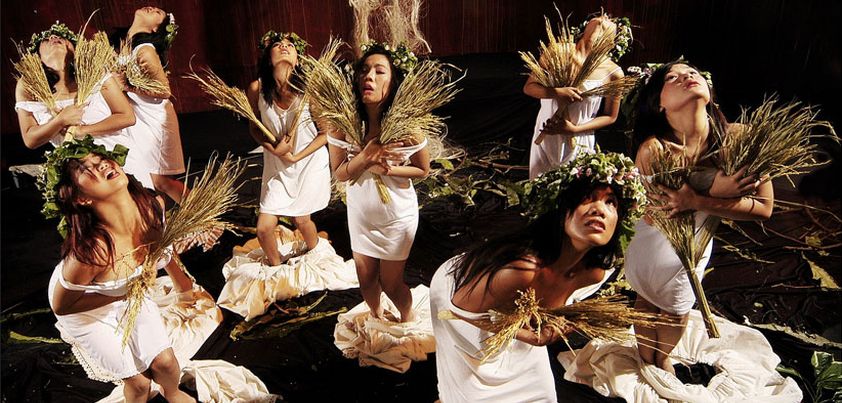 This story by Filipino writer Nick Joaquin takes place over the final two days of a “hybrid” religious festival. Because both take place over the summer solstice, the Catholic feast of St John and pagan Tadtarin fertility rituals are celebrated together. Tadtarin is performed exclusively by women (or men dressed up as women), invoking their power to ensure a bountiful harvest. Events lead to an unsettling climax where a usually submissive wife pitilessly humiliates her rich landowner husband. Themes include gender stereotypes (especially male domination and cruelty towards women) and cultural changes brought about by Westernization. More…
This story by Filipino writer Nick Joaquin takes place over the final two days of a “hybrid” religious festival. Because both take place over the summer solstice, the Catholic feast of St John and pagan Tadtarin fertility rituals are celebrated together. Tadtarin is performed exclusively by women (or men dressed up as women), invoking their power to ensure a bountiful harvest. Events lead to an unsettling climax where a usually submissive wife pitilessly humiliates her rich landowner husband. Themes include gender stereotypes (especially male domination and cruelty towards women) and cultural changes brought about by Westernization. More…
A Perfect Day for Bananafish
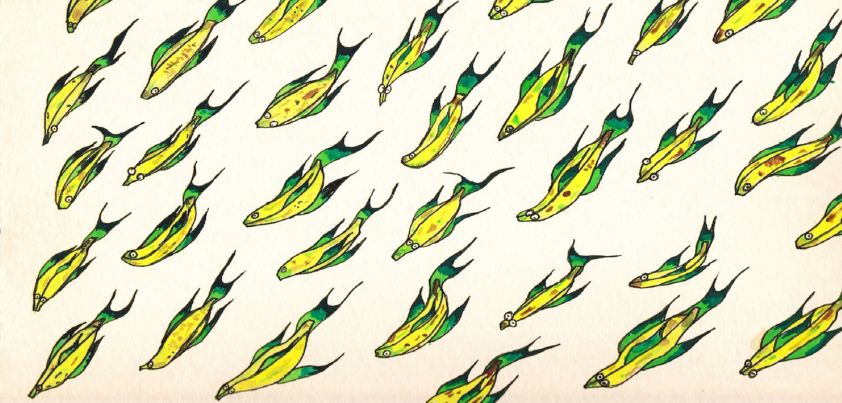 The major theme of this J. D. Salinger story is an extension of another we have featured by the same author. In For Esmé with Love and Squalor, a teenager’s friendship and compassion help a young soldier recover from PTSD. Here, a returned soldier is suffering its long-term effects. He copes by trying to avoid the company of adults (including his vain, materialistic wife) and finds pleasure in music, poetry and spending time with young children. Major themes: the effects of war on mental health, alienation, loneliness, childhood innocence, vanity and materialism, suicide. More…
The major theme of this J. D. Salinger story is an extension of another we have featured by the same author. In For Esmé with Love and Squalor, a teenager’s friendship and compassion help a young soldier recover from PTSD. Here, a returned soldier is suffering its long-term effects. He copes by trying to avoid the company of adults (including his vain, materialistic wife) and finds pleasure in music, poetry and spending time with young children. Major themes: the effects of war on mental health, alienation, loneliness, childhood innocence, vanity and materialism, suicide. More…
The Red Bow
 This dystopian story from George Saunders is often referred to as a metaphor for the post 9-11 Afghan and Iraq Wars. It is also an allegory of a much older, far-reaching problem: ethnic cleansing. A small group of dogs (people) is seen as a direct threat and are eliminated. After this, paranoia sets in. All dogs and cats (minority groups) become suspect and must also be removed. The dictatorial rise of Uncle Max by exploiting fear of the perceived “enemy” is also symbolic of the way many world leaders have come to power. Themes: tragedy, grief, paranoia, protection, authoritarianism. More…
This dystopian story from George Saunders is often referred to as a metaphor for the post 9-11 Afghan and Iraq Wars. It is also an allegory of a much older, far-reaching problem: ethnic cleansing. A small group of dogs (people) is seen as a direct threat and are eliminated. After this, paranoia sets in. All dogs and cats (minority groups) become suspect and must also be removed. The dictatorial rise of Uncle Max by exploiting fear of the perceived “enemy” is also symbolic of the way many world leaders have come to power. Themes: tragedy, grief, paranoia, protection, authoritarianism. More…
And of Clay Are We Created
 This confronting story from Isabel Allende is based on the real life plight of Omayra Sánchez, killed in a volcanic eruption in 1985. It highlights the confusion and suffering that often accompanies natural disasters, and the human and psychological tolls on both victims and responders. The irony of the story is that despite the massive resources employed by news agencies to cover the incident, they were unable to locate and bring in a pump to save the girl. Themes include man against nature, compassion, courage, faith/acceptance of fate, the healing effect of facing and sharing past tragedies. More…
This confronting story from Isabel Allende is based on the real life plight of Omayra Sánchez, killed in a volcanic eruption in 1985. It highlights the confusion and suffering that often accompanies natural disasters, and the human and psychological tolls on both victims and responders. The irony of the story is that despite the massive resources employed by news agencies to cover the incident, they were unable to locate and bring in a pump to save the girl. Themes include man against nature, compassion, courage, faith/acceptance of fate, the healing effect of facing and sharing past tragedies. More…